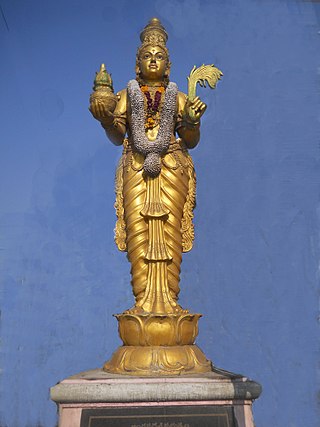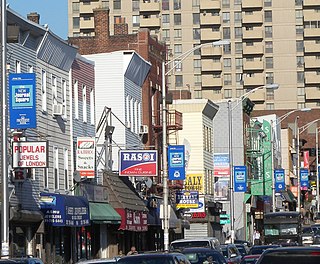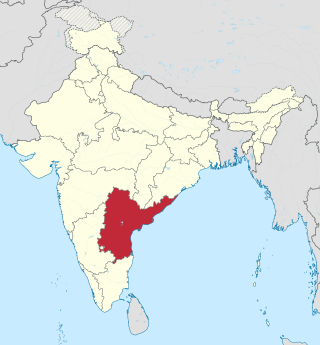
Calyampudi Radhakrishna Rao was an Indian-American mathematician and statistician. He was professor emeritus at Pennsylvania State University and Research Professor at the University at Buffalo. Rao was honoured by numerous colloquia, honorary degrees, and festschrifts and was awarded the US National Medal of Science in 2002. The American Statistical Association has described him as "a living legend” whose work has influenced not just statistics, but has had far reaching implications for fields as varied as economics, genetics, anthropology, geology, national planning, demography, biometry, and medicine." The Times of India listed Rao as one of the top 10 Indian scientists of all time.

Mayabazar is a 1957 Indian epic Hindu mythological film directed by K. V. Reddy. It was produced by Nagi Reddi and Chakrapani under their banner, Vijaya Productions. The film was shot simultaneously in Telugu and Tamil, with a few differences in the cast. The story is an adaptation of the folk tale Sasirekha Parinayam, which is based on the characters of the epic Mahabharata. It revolves around the roles of Krishna and Ghatotkacha, as they try to reunite Arjuna's son Abhimanyu with his love, Balarama's daughter Sasirekha (Savitri). The Telugu version features Gummadi, Mukkamala, Ramana Reddy, and Relangi in supporting roles, with D. Balasubramaniam, R. Balasubramaniam, V. M. Ezhumalai, and K. A. Thangavelu playing those parts in the Tamil version.

Nandamuri Balakrishna, widely known as Balakrishna and Balayya is an Indian actor, producer and politician known for his works in Telugu cinema. Balakrishna is an elected member of the Andhra Pradesh Legislative Assembly from Hindupuram constituency since 2014. The sixth son of Legendary actor and former Chief Minister of Andhra Pradesh N. T. Rama Rao, Balakrishna made his debut as a child artist at the age of 14 with the film Tatamma Kala (1974). Balakrishna is a recipient of three state Nandi Awards and one South Indian International Movie Award. In 2012, Balakrishna was the chief guest at the 43rd IFFI. Currently He serves as the Chairman of Basavatarakam Indo-American Cancer Hospital and Research Center in Hyderabad.

Bangladeshi Americans are Americans of Bangladeshi descent. Most Bangladeshi Americans are also Bengali Americans. Bangladeshi Americans are usually Muslims with roots in Bangladesh in which Bengali is the majority language. Since the early 1970s, Bangladeshi immigrants have arrived in significant numbers to become one of the fastest growing ethnic groups in the U.S. New York City is home to two-thirds of the Bangladeshi American population. Meanwhile, Paterson, New Jersey and Atlantic City, New Jersey are also home to notable Bangladeshi communities. Over 400,000 people leave Bangladesh with the sole goal of finding employment in other countries.

Telugu people, also called Andhras, are an ethno-linguistic group who speak the Telugu language and are native to the Indian states of Andhra Pradesh, Telangana and Yanam district of Puducherry. They are the most populous of the four major Dravidian groups. Telugu is the fourth most spoken language in India and the 14th most spoken native language in the world. A significant number of Telugus also reside in the Indian states of Karnataka, Tamil Nadu, Orissa, Maharashtra. Members of the Telugu diaspora are spread across countries like United States, Australia, Malaysia, Mauritius, UAE, and others. By 2024 Telugu is spoken by 95.7 million people all over world, which makes it the third largest Indian diaspora after Hindi and Bengali. Telugu is the fastest-growing language in the United States. It is also a protected language in South Africa.

Telugu cinema, also known as Tollywood, is the segment of Indian cinema dedicated to the production of motion pictures in the Telugu language, widely spoken in the states of Andhra Pradesh and Telangana. Telugu cinema is based in Film Nagar, Hyderabad. As of 2021, Telugu cinema is the largest film industry in India in terms of box-office. Telugu films sold 23.3 crore tickets in 2022, the highest among various film industries in India.

Minnesota's 4th congressional district covers nearly all of Ramsey County, and part of Washington County. It includes all of St. Paul, and most of its northern and eastern suburbs, including Woodbury, Blaine, Roseville, and Maplewood. The district is solidly Democratic, with a CPVI of D+17. It is currently represented by Betty McCollum, of the Minnesota Democratic-Farmer-Labor Party (DFL). The DFL has held the seat without interruption since 1949, and all but one term (1947–1949) since the merger of the Democratic and Farmer-Labor Parties.

Nandamuri Taraka Rama Rao Jr., also known as Jr. N.T.R. or Tarak, is an Indian actor who primarily works in Telugu cinema. One of the highest paid Telugu film actors, Rama Rao has won several accolades, including two Filmfare Awards, two state Nandi Awards, and four CineMAA Awards. Since 2012, he has been featured in Forbes India's Celebrity 100 list.

Bhakta Prahlada is a 1932 Indian Telugu-language Hindu mythological film directed by H. M. Reddy and produced by Ardeshir Irani of Imperial Film Company. It is the first sound film of Telugu cinema. It features Sindhoori Krishna Rao as the titular Prahlada, along with Munipalle Subbayya, Surabhi Kamalabai, Doraswamy Naidu, Chitrapu Narasimha Rao, and L. V. Prasad. No complete synopsis of the film that is known to survive, but it is an adaptation of a play of the same name.

Lava Kusa is a 1963 Indian Hindu mythological film directed by C. S. Rao and his father C. Pullayya. The film was scripted by Sadasivabrahmam, Samudrala Sr. along with C. S. Rao and C. Pullayya. The film was produced by Sankara Reddy under Lalita Sivajyothi Films. Lava Kusa is the first full-length colour film of Telugu cinema.
The District of Columbia is a federal district with an ethnically diverse population. In 2020, the District had a population of 689,545 people, with a resident density of 11,515 people per square mile.

Singeetam Srinivasa Rao, commonly known as Singeetam, is an Indian film director, screenwriter, producer, composer, and actor. He is widely regarded as one of the most versatile filmmakers of India. He is credited with having revolutionised the South Indian cinema with experimental films. He has directed about sixty films in Telugu, Kannada, Tamil, Hindi, and English languages across multiple genres. He has garnered two National Film Awards, five Nandi Awards, three Karnataka State Film Awards, and three Filmfare Awards South. In 2011, Rao was honored with Life Achievement Award from the Film Federation of India.

Sri Sarathi Studios is a film studio facility located in Ameerpet, Hyderabad, India. It was established in 1956 and was the first film studio facility built in Hyderabad. It was built by the Raja of Challapalli, Yarlagadda Sivarama Prasad. The first film shot in the studio was Maa Inti Mahalakshmi (1959). It was also the first Telugu film to be completely filmed in Hyderabad.
The Akkineni–Daggubati family is a prominent Indian film family with a history predominantly in Telugu cinema. Akkineni Nageswara Rao and Daggubati Ramanaidu are the prominent heads of both families. Members of the family include actors, film directors, and producers.

Indians in the New York City metropolitan area constitute one of the largest and fastest-growing ethnicities in the New York City metropolitan area of the United States. The New York City region is home to the largest and most prominent Indian American population among metropolitan areas by a significant margin, enumerating 711,174 uniracial individuals based on the 2013–2017 U.S. Census American Community Survey estimates. The Asian Indian population also represents the second-largest metropolitan Asian national diaspora both outside of Asia and within the New York City metropolitan area, following the also rapidly growing and hemisphere-leading population of the estimated 893,697 uniracial Chinese in the New York City metropolitan area in 2017.
Blue Planet Entertainments LLP is an Indian film production company established by Kiran Reddy Mandadi and CH Bharath Chowdary. The company is based in Hyderabad and has produced around 3 films in Telugu languages delivered several successful projects from the beginning, the film Nene Raju Nene Mantri directed by Teja, featuring Rana Daggubati, Kajal Aggarwal, Catherine Tresa, and Navdeep in the lead roles.

Andhra Pradesh, retrospectively referred to as United Andhra Pradesh, Undivided Andhra Pradesh or Ummadi Andhra Pradesh, was a state in India formed by States Reorganisation Act, 1956 with Hyderabad as its capital and was reorganised by Andhra Pradesh Reorganisation Act, 2014. The state was made up of three distinct cultural regions of Telangana, Rayalaseema, and Coastal Andhra. Before the 1956 reorganisation, Telangana had been part of Hyderabad State ruled by Nizam of Hyderabad, whereas Rayalaseema and Coastal Andhra had been part of Andhra State, formerly a part of Madras Presidency ruled by British India.
The SIIMA Award for Best Film – Telugu is presented by Vibri media group as part of its annual South Indian International Movie Awards for Telugu films. The award was first given in 2012 for films released in 2011.
Asian Virginians make up 7% of Virginia's population, and up to at least 7.5% including those considered partially Asian. The population is at least 500,000. The largest Asian groups in Virginia are mainly Indians, Chinese, Filipinos, Koreans, and Vietnamese. The state has the 8th highest percentage of Asian residents according to the 2010 Census, and is culturally connected and rooted with its Asian community.














